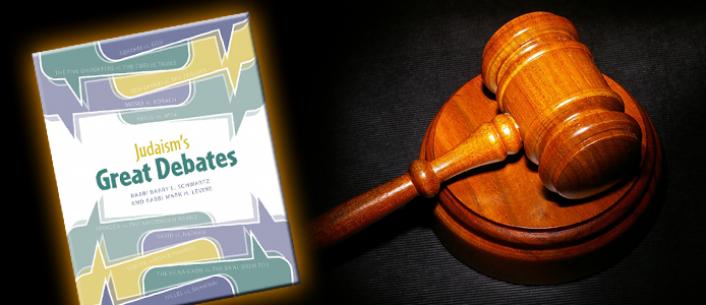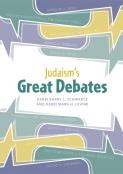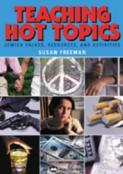- Home
- Play & Learn Home
- Online Enrichment
- Experience Modern Israel
- Israel It's Complicated
- Jewish and Me
- Jewish Holidays Jewish Values
- Jewish Values in Genesis and Jewish Values in Exodus
- Min Ha’aretz
- Our Place in the Universe
- Simply Seder
- The Prophets: Speaking Out for Justice
- Making T'filah Meaningful
- Make, Create, Celebrate
- Yom Haatzmaut Resources
- Hebrew Apps
- About The OLC
- What is the OLC?
- Introduction
- Get Started
- Resources
- OLC Content
- Parent Materials
- See My OLC Classes
- Store
Arguing for the Sake of Heaven: Teach Teens the Art of Jewish Debate
Written by Behrman House Staff, 18 of May, 2012
by Rabbi Barry L. Schwartz
Throughout my twenty five years as a rabbi I have taught teens in confirmation and post-confirmation classes. No experience has been more thrilling than the formal debates I recently conducted in those classes. These debates grew out of my new book, Judaism’s Great Debates: Timeless Controversies from Abraham to Herzl which has just been published in both youth (Behrman House) and adult (JPS) editions.
Teens (like their adult counterparts) love to debate. I should know, as a rabbi who has studied our Jewish heritage which is full of debate, but also as a former high school debater. It was then that I was introduced to the art of formal debate. Formal debate is something of a lost art today, outside of a few specialized debating societies. This brief piece is a call to revive formal debate in the Jewish classroom.
Formal debate compels a student to think and analyze and articulate. An effective debater will organize and prioritize. A highly effective debater must also be an astute listener, all the more to cross examine the opposition and rebut their claims. Debating as a team puts a high priority on cooperation and consensus building.
I’ll never forget the debate we once had on the subject of collective punishment, based on the opening chapter of my book on the debate between Abraham and God in Genesis 18 regarding the destruction of Sodom and the possibility of the innocent being killed with the guilty. The resolution I placed before the class concerned whether the dropping of the atomic bomb on Hiroshima and Nagasaki was morally justified. After providing background material on the subject, I was stunned at how articulate and passionate both sides of the debate became. Keep in mind that students were assigned which position to argue regardless of their personal feelings. At the end some of my students admitted that their previous views of the issue had been shaken; other felt fortified in their feelings; yet others admitted that their ignorance or apathy had been permanently altered.
An especially rewarding aspect of such debate is how intently students must listen to each other and thus learn from each other. Yet the role of the teacher in facilitating and skillfully judging the debate is crucial in giving it seriousness of purpose. In the process teacher and students are engaging in a venerable dialogue that is given a unique expression by our sages: makhloket l’shem shamayim-an argument for the sake of heaven. Such worthy debate has an honored place in our tradition. At the same time, it makes for high drama in the classroom that is downright compelling.
So here is a brief guide to making that debate happen. For debate topics both ancient and contemporary see the “Room for Debate” section at the back of the adult edition of Judaism's Great Debates and the “Debate It” section of each chapter of the youth edition. A Lesson Plan Manual and website are also available from Behrman House.
THE ART OF DEBATE: TEN EASY STEPS
1. Study the issue
2. Craft a resolution
3. Divide into teams
4. Appoint captain and speakers
5. Outline your case
6. Opening statements
7. Cross Examination
8. Rebuttal/Summary
9. Judge’s Review
10. Student Review
A classroom debate begins by studying the issue at hand. Read and discuss the chapter and examine the questions for reflection and debate that accompany each issue.
Choose one question and craft a resolution, Resolved that...in the form of a positive statement.
Divide into two teams, affirmative (for) and negative (against). Appointments should be made by the teacher and not based on personal views of the issue. The group should then appoint a captain and divide speaking responsibilities. Utilize index cards to then outline your case.
Opening arguments should begin with the affirmative team, then the negative. Cross examination, with a specified number of questions or time limit should take place. Rebuttal and summary closes the formal debate.
The teacher (judge) should score the debate as it unfolds and then offer a review and verdict. Students then are asked to review their own performance, that of the team, and ultimately their personal view of the subject and if it has evolved during the debate. Concluding remarks may then be offered by the teacher.
How about forming a debate team and hosting a debate tournament with another class or school? Not just the lawyers-to-be will love it. Is this a fun and effective way to learn? There’s no debate about it!
Find out more about Judaism’s Great Debates and order the book here.



